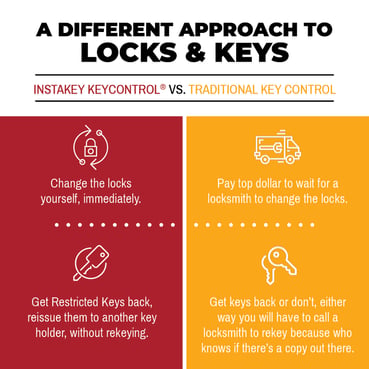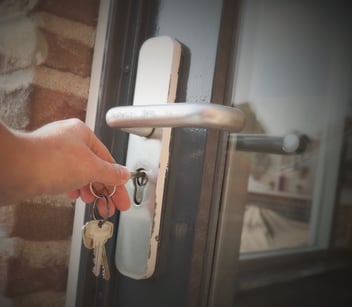The History of Commercial Key Cores
Key cores are an integral part of most mechanical key systems. Key cores are used in primarily commercial settings and offer strong and reliable security. To understand how commercial key cores have grown to dominate key control in physical security, let’s take a trip back in time to look at the development of lock and key systems throughout history. While many of us don’t spare much thought for the technological advancements that have led to today’s locks and keys, it is only through continual innovation that we have the security and convenience of today's commercial key cores.

Who invented locks and keys?
Locks and keys have been around for centuries as an effective way to keep goods, valuables, and people secure. The oldest known lock in the world was used 4,000 years ago in an ancient Egyptian society and was made of wood. The keys looked similar to a long wooden toothbrush, with levers in place of the brush. Those levers would correspond to the pins within a wooden housing system.
The Romans invented metal locks and keys fairly similar to what is used today. Projections within the lock allowed a key made with corresponding cuts to open it. Locksmiths would make complex lock and key designs to increase security, but the locks were still relatively easy to pick.
Lock and key complexity continued to advance with the creation of a tumbler system in the 1700’s. Tumbler locks increased security by making it much more difficult to pick. With a tumbler lock, multiple levers within the locking mechanism have to be lifted to a certain height to turn the bolt. Locksmiths continued to build on the tumbler lock by adding more sensitive pins to create the lock and key mechanism that we’re familiar with today — and the commercial key core.
What is a key core?
As locks and keys have developed throughout history, the ingenuity of locksmiths has led to a streamlined locking system based on key cores. Key cores allow for locks to be changed without the need to take the entire lock housing or door handle off.
A key core is a small cylinder that fits inside of a lock housing and allows a key to be inserted. The housing of a lock is what fits into the door or other fixture and remains, even when your locks are changed, or the key cores are replaced. Key cores are present in almost every lock and key system and they come in many forms, from standard conventional to small format interchangeable (SFIC).
Key cores are an integral part of maintaining security for commercial purposes. Imagine if you were managing a large facility with many locks and every door handle and locking mechanism had to be removed to update your security. That would be a mess. Key cores allow facility managers to update security after a key is lost or stolen with considerably less work than what was required of the Romans.
Standard Cores vs. Interchangeable Cores
Modern-day key cores come in two primary types. A standard key core (also known as conventional) is cheaper to install and effectively protects homes, offices, and facilities across the world, but costs more when you have to rekey. Interchangeable cores (large and small format) are typically more costly to implement but offer greater control and convenience when managing many locks or multi-site organizations.
Standard Cores
A standard key core can only be rekeyed by a professional locksmith, who removes the core from the lock and inserts another or repins the core. The process isn’t too daunting when only a few locks are involved, but rekeying a standard core takes ten to thirty minutes per lock and that can quickly add up with multiple locks in a facility or multiple facilities to rekey. Not to mention the key distribution that has to occur for all key holders whenever an associated lock is rekeyed or replaced.
Interchangeable Cores
Interchangeable cores are much easier to manage because these key cores can be removed from housings with the use of a Control Key. From there cores can be repinned or rekeyed. Some interchangeable cores can be rekeyed while still in the housing, which is even faster than repinning. In contrast to a standard core, interchangeable cores don’t necessarily require professional maintenance to rekey or switch out.
Interchangeable cores were created by Frank Best, who worked at a large high school in Washington State and grew frustrated with carrying hundreds of keys daily and the process of rekeying an entire lock every time a key was lost. After seven years of experimentation, he created the first small format interchangeable key core (SFIC) in 1919, which allowed for a key core to be replaced with a Control Key without the need to call in a locksmith.
As rekeying is a regular undertaking for most commercial facilities, it’s common to have key cores in storage to have on-hand when a rekey is necessary. While it’s certainly a more effective system than wooden locks and toothbrush keys, storing key cores can be frustrating when space is at a premium.
Rekeyable Cores
While interchangeable cores changed the lock and key field in the early twentieth century, it wasn’t a perfect solution to the frustrations of large scale rekeying. Interchangeable cores make the rekeying process easier, but still requires a replacement core every time a lock needs to be changed. This becomes a storage and procurement hassle.
Luckily, the key core field continues to evolve. In the 1980s, InstaKey developed a new key core to address the lingering frustrations of interchangeable cores — rekeyable cores. Rekeyable cores work with a Step Change Key to shear off a wafer inside the core, essentially repinning it. These cores allow for this to happen up to nine times before the core needs to be removed from the housing to be repinned or replaced. Changing a rekeyable lock doesn’t require any assistance from a locksmith and can cut down on the need to store cores in bulk to be ready for the next re-core event. While interchangeable and rekeyable cores can be more expensive to implement than traditional standard cores, the long-term benefits in time and cost savings are considerable, especially for large multi-site commercial organizations.

While locks and keys continued to advance, the way they are controlled and managed also needed some innovation. After installation, most key systems quickly become out of control because keys can be duplicated without authorization. This can be controlled with restricted keys. And when restricted keys are uniquely serialized and tracked in a cloud-based records database, managing and controlling such a system becomes much easier, secure, and cost-effective. This was a necessary advancement for multi-site commercial businesses, where key control can become costly and inefficient very quickly. Implementing an effective and easily managed key control system can save you the headache of handling time-consuming and expensive key core replacements and trying to keep track of who has keys to what.
Locks and keys have been advancing for the last 4,000 years. While your key management system is likely more impressive than the ancient Egyptians’, there may still be improvements that could simplify your key control and make it more cost-effective. Get in touch with a security specialist today to see how InstaKey can help your business stay on the forefront of commercial key core innovation.
Wondering how the InstaKey approach is different? Take a look at our full infographic to see how locks & keys will help you save time, money & create a more secure environment at your locations by clicking the button below.





